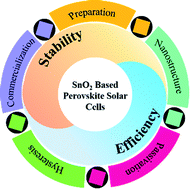Advances in SnO2-based perovskite solar cells: from preparation to photovoltaic applications
Abstract
Perovskite solar cells (PSCs) have recently demonstrated a rapid power conversion efficiency of above 25%. In terms of physical properties, SnO2 is similar to TiO2 but with stronger charge extraction at the interface. Furthermore, the SnO2 electron transporting layer (ETL) is prepared using new, simple, and efficient methods, resulting in high-performance PSCs. This review initially described recent progress in SnO2 nanostructures and preparation methods. The passivation options were then divided into elemental doping, bilayer alterations, and interfacial modifications. Finally, we discussed the challenges and limitations of SnO2 ETL-based PSCs and made recommendations for further research.

- This article is part of the themed collection: Journal of Materials Chemistry A Emerging Investigators


 Please wait while we load your content...
Please wait while we load your content...